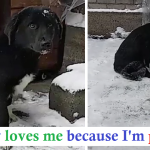As if being stung by 1000’s of bees wasn’t already dangerous sufficient, he was deserted at a shelter after the incident by his household.
The deaf Pit Bull arrived on the shelter lined with life-threatening blisters throughout his physique. Rescuers later gave him the title Stinger.
They supposed to place the dog to loss of life as a result of they may not deal with him.
At that time, Carri Shipaila, proprietor of LuvnPupz Rescue in Better Grand Rapids, Michigan, intervened to supply help. She jumped in her automotive as quickly as she realized about Stinger and drove practically an hour to choose him up from the shelter.
She immediately began working to avoid wasting Stinger’s life when his household regrettably denied to take him. His stings, a later pores and skin an infection, and sarcoptic mange had been all handled.
Regrettably, he ended up creating the autoimmune illness Pemphigus, which might have an effect on him for the remainder of his life.
He won’t ever be obtainable for adoption because of the excessive prices of his care, however he did discovered a loving without end residence with a foster and can proceed to get care and remedy via LuvnPupz.
Since being deserted on the shelter, Stinger has come a great distance. His excruciating blisters at the moment are healed, and he wears a shocking white coat.
He’s thriving in his new life in a loving residence and is such a contented, loving dog!
Taking care of a dog’s hair involves several important steps to ensure their coat stays healthy and clean:
-
- Regular Brushing: Brushing your dog’s hair is crucial for removing loose fur, dirt, and debris, which can lead to mats and tangles if left unattended. The frequency of brushing depends on your dog’s coat type. Dogs with long hair, such as Golden Retrievers or Afghan Hounds, may require daily brushing to prevent matting. On the other hand, short-haired breeds like Beagles or Boxers may only need brushing a few times a week. Use a brush appropriate for your dog’s coat type, such as a slicker brush for long-haired breeds or a rubber curry brush for short-haired breeds.
- Bathing: Bathing your dog helps keep their coat clean and fresh-smelling. Use a dog-specific shampoo, as human shampoos can be too harsh and strip their skin of natural oils. The frequency of baths depends on your dog’s lifestyle and coat type. Dogs that spend a lot of time outdoors or have a tendency to get dirty may need baths more frequently than indoor dogs. However, over-bathing can lead to dry skin and coat, so aim for once a month unless your dog specifically needs more frequent baths.
- Trimming: Regular trimming is essential for preventing matting and keeping your dog comfortable. Pay attention to areas prone to matting, such as behind the ears, under the legs, and around the tail. You can use scissors or clippers to trim your dog’s hair, but be cautious not to cut too close to the skin, especially in sensitive areas. If you’re unsure, it’s best to seek the help of a professional groomer.
- Diet: A balanced diet is essential for maintaining a healthy coat. Look for dog foods that contain high-quality proteins, essential fatty acids, vitamins, and minerals. Omega-3 and omega-6 fatty acids, found in fish oil and flaxseed oil, are particularly beneficial for skin and coat health. Consult with your veterinarian to choose the best diet for your dog’s specific needs.
- Hydration: Proper hydration is vital for healthy skin and coat. Make sure your dog has access to clean, fresh water at all times. Dehydration can lead to dry, flaky skin and a dull coat.
- Regular Vet Check-ups: Regular visits to the veterinarian are essential for monitoring your dog’s overall health, including their skin and coat. Your vet can check for any underlying health issues that may affect your dog’s coat, such as allergies, skin infections, or hormonal imbalances.
- Supplements: In some cases, your vet may recommend supplements to support your dog’s coat health. Fish oil supplements are commonly recommended for their omega-3 fatty acids, which can help reduce inflammation and improve skin and coat condition. Other supplements, such as biotin or specialized skin and coat formulas, may also be beneficial depending on your dog’s specific needs.
- Environmental Considerations: Protect your dog’s coat from environmental factors that can damage it, such as extreme heat, cold, and harsh sunlight. Provide shade and shelter when outdoors, and consider using protective clothing or sunscreen for dogs with light-colored or thin coats. After outdoor activities, check your dog for ticks, burrs, or other debris that may have become lodged in their coat.
By following these detailed steps, you can ensure that your dog’s coat remains healthy, shiny, and free from common issues like mats, tangles, and dryness. Regular grooming and proper care are essential for keeping your furry friend looking and feeling their best!








